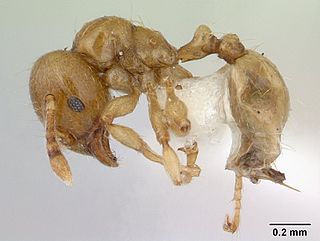Related Research Articles

The flowering plant family Lauraceae, the laurels, includes the true laurel and its closest relatives. This family comprises about 2850 known species in about 45 genera worldwide. They are dicotyledons, and occur mainly in warm temperate and tropical regions, especially Southeast Asia and South America. Many are aromatic evergreen trees or shrubs, but some, such as Sassafras, are deciduous, or include both deciduous and evergreen trees and shrubs, especially in tropical and temperate climates. The genus Cassytha is unique in the Lauraceae in that its members are parasitic vines.

Allomerus decemarticulatus is an Amazonian ant species found in the tropics of South America. This species is most notable for the workers’ complex and extreme predatory behavior, which involves a symbiosis with both a plant and fungal species. They live in leaf pockets of a host plant species, Hirtella physophora. These leaf pockets are areas inside of the plant between the leaves and the stem. Each colony, which consists of about 1,200 workers, inhabits a single tree; however, the ants are spread among the leaf pockets, with typically 40 workers per pocket. Their diet primarily consists of large insects that are captured on the plant, but they also eat some kinds of food bodies produced by the plant as well as its nectar. They are able to capture their prey, which is much larger than themselves, by constructing a platform that acts as a trap for the unsuspecting prey. The ants hide in the trap and attack when any insect lands on it. This technique is an example of ambush predation.

Dolichoderinae is a subfamily of ants, which includes species such as the Argentine ant, the erratic ant, the odorous house ant, and the cone ant. The subfamily presents a great diversity of species throughout the world, distributed in different biogeographic regions, from the Palearctic, Nearctic, Afrotropical region and Malaysia, to the Middle East, Australian, and Neotropical regions.

Myrmecophytes are plants that live in a mutualistic association with a colony of ants. There are over 100 different genera of myrmecophytes. These plants possess structural adaptations that provide ants with food and/or shelter. These specialized structures include domatia, food bodies, and extrafloral nectaries. In exchange for food and shelter, ants aid the myrmecophyte in pollination, seed dispersal, gathering of essential nutrients, and/or defense. Specifically, domatia adapted to ants may be called myrmecodomatia.

In myrmecology and forest ecology, a devil's garden is a large stand of trees in the Amazon Rainforest consisting of at most three tree species and ant. Devil's gardens can reach up to sizes of 600 trees and are inhabited by a single ant colony, containing 3 million workers and 15,000 queens. In a 2002 to 2004 census of the Amazon, Devil's gardens were shown to have grown by 0.7 percent per year. The relationship between tree and ant may persist for more than 800 years.

Vachellia collinsii is a species of flowering plant. It grows in secondary succession in seasonally dry ecosystems in southern Central America, where it exhibits a symbiotic relationship with several species of ant. The ant-Vachellia system involving this species has been studied by ecologists like Daniel Janzen in Palo Verde National Park and Santa Rosa National Park, both in Guanacaste Province, Costa Rica. The ants chew holes in the tips of the hollow stipular thorns, known as domatia, so that they can enter, and create their colony inside. A single ant colony may span several V. collinsii trees.

Matthew Hilary Peter Jebb is an Irish botanist and taxonomist specialising in the ant plant genera Squamellaria, Myrmecodia, Hydnophytum, Myrmephytum and Anthorrhiza, as well as the carnivorous plant genus Nepenthes.
Humboldtia is a genus of flowering plants in the legume family, Fabaceae. Most species are endemic to India.

A domatium is a tiny chamber produced by plants that houses arthropods.

Dischidia major, the Malayan urn vine, is an unusual plant. Dischidia is a genus of some 80 species of trailing, twining or scandent, succulent epiphytes found throughout the tropics of Asia through to the western Pacific. They carry modified leaves, offering accommodation to ants, including those of the family Dolichoderinae, and in return gain some sustenance from increased carbon dioxide and nitrogen levels, and a degree of protection from noxious animals and plants. This mutualism trait, known as myrmecophily, is widespread across the plant world and clearly carries considerable benefits for both ants and plant.

Philidris is a genus of ants in the subfamily Dolichoderinae. The genus is known from tropical forests from eastern India to northern Australia. It is similar to the genus Iridomyrmex, from where the type species was transferred from by Shattuck (1992).
Myrmephytum is a genus of myrmecophytic flowering plants in the family Rubiaceae. It is distributed from central Malesia to New Guinea.

Squamellaria is a genus of myrmecophytic flowering plants in the family Rubiaceae. It is endemic to the islands of Fiji.

Philidris cordata is a species of ant in the genus Philidris. Described by Smith in 1859, the species is endemic to Indonesia and New Guinea. This species is a frequent inhabitant of the ant plant genera: Myrmecodia and Hydnophytum.
Philidris cruda is a species of ant in the genus Philidris. Described by Smith in 1860, the species is endemic to Indonesia.
Philidris jiugongshanensis is a species of ant in the genus Philidris. Described in Wang and Wu in 2007, the species is endemic to China.
Philidris pubescens is a species of ant in the genus Philidris. Described by Donisthorpe in 1949, the species is endemic to New Guinea.
Philidris laevigata is a species of ant in the genus Philidris. Described by Emery in 1895, the species is endemic to Burma, India and China.
Philidris myrmecodiae is a species of ant in the genus Philidris. Described by Emery in 1887, the species is endemic to Asia.
Philidris notiala is a species of ant in the genus Philidris. Described by Zhou and Zheng in 1998, the species is endemic to China.
References
- ↑ Shattuck, S. O. 1992a. Review of the dolichoderine ant genus Iridomyrmex Mayr with descriptions of three new genera (Hymenoptera: Formicidae). Australian Journal of Entomological Society31: 13-18 (page 18, Combination in Philidris)
- ↑ https://www.sciencedaily.com/releases/2016/11/161122080005.htm
- ↑ Chomicki, Guillaume; Renner, Susanne S. (21 November 2016). "Obligate plant farming by a specialized ant". Nature Plants. 2: 16181. doi:10.1038/nplants.2016.181. PMID 27869787.
| This Dolichoderinae-related article is a stub. You can help Wikipedia by expanding it. |